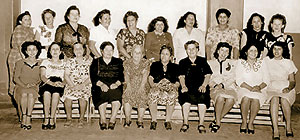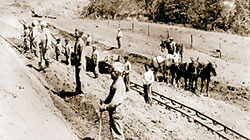American citizenship conferred many rights and privileges but only “free white men” were eligible to apply. In the US, many anthropologists used “Caucasian” as a general term for “white” in absence of any precise definition of word “white”. Indian nationals from the north of the Indian subcontinent and people from some Middle East countries were also considered Caucasian. Thus, several Indians were granted US citizenship in different states. Bhagat Singh Thind, who had joined US army, also applied for citizenship in the state of Washington in July 1918. He received his citizenship certificate on December 9, 1918 wearing military uniform. However, the Immigration and Naturalization Service (INS) did not agree with the district court granting the citizenship. Thind’s citizenship was revoked in four days, on December 13, 1918, on the grounds that he was not a “free white man”.
 Thind applied for citizenship again from the neighbouring state of Oregon on May 6, 1919. The same INS official who got Thind’s citizenship revoked first time, tried to convince the judge to refuse citizenship to a “Hindoo” from India. He even brought up the issue of Thind’s involvement in the Gadar Movement, members of which campaigned for the independence of India from Britain. But Thind contested this charge and Judge Wolverton believed him. The judge observed, “He (Thind) stoutly denies that he was in any way connected with the alleged propaganda of the Gadar Press to violate the neutrality laws of this country, or that he was in sympathy with such a course. He frankly admits, nevertheless, that he is an advocate of the principle of India for the Indians, and would like to see India rid of British rule, but not that he favours an armed revolution for the accomplishment of this purpose.” The judge took all arguments as also Thind’s military record into consideration and did not support the INS argument. Thus, Thind received US citizenship for the second time on November 18, 1920. The INS, however, appealed to the next higher court — the Ninth Circuit Court of Appeals which sent the case to the US Supreme Court for ruling. Thind applied for citizenship again from the neighbouring state of Oregon on May 6, 1919. The same INS official who got Thind’s citizenship revoked first time, tried to convince the judge to refuse citizenship to a “Hindoo” from India. He even brought up the issue of Thind’s involvement in the Gadar Movement, members of which campaigned for the independence of India from Britain. But Thind contested this charge and Judge Wolverton believed him. The judge observed, “He (Thind) stoutly denies that he was in any way connected with the alleged propaganda of the Gadar Press to violate the neutrality laws of this country, or that he was in sympathy with such a course. He frankly admits, nevertheless, that he is an advocate of the principle of India for the Indians, and would like to see India rid of British rule, but not that he favours an armed revolution for the accomplishment of this purpose.” The judge took all arguments as also Thind’s military record into consideration and did not support the INS argument. Thus, Thind received US citizenship for the second time on November 18, 1920. The INS, however, appealed to the next higher court — the Ninth Circuit Court of Appeals which sent the case to the US Supreme Court for ruling.
 Supreme Court Justice George Sutherland delivered the unanimous opinion of the court on February 19, 1923, in which he argued that since the “common man’s” definition of “white” did not correspond to “Caucasian”, Indians could not be naturalised. Shockingly, the very same Judge Sutherland who had equated Whites as Caucasians in US vs Ozawa, now pronounced that Thind though Caucasian, was not “White” and thus was ineligible for US citizenship. He apparently decided the case under pressure from the forces of prejudice, racial hatred and bigotry, not on the basis of precedent that he had established in a previous case. Supreme Court Justice George Sutherland delivered the unanimous opinion of the court on February 19, 1923, in which he argued that since the “common man’s” definition of “white” did not correspond to “Caucasian”, Indians could not be naturalised. Shockingly, the very same Judge Sutherland who had equated Whites as Caucasians in US vs Ozawa, now pronounced that Thind though Caucasian, was not “White” and thus was ineligible for US citizenship. He apparently decided the case under pressure from the forces of prejudice, racial hatred and bigotry, not on the basis of precedent that he had established in a previous case.
|
Indians were excluded from immigration, persecuted for their political activities, threatened with deportation, excluded from citizenship, denaturalised, excluded from land ownership, and regulated even in their choice of a mate |
The Supreme Court verdict shook the faith and trust of Indians in the American justice system. The economic impact for land and property owning Indians was devastating as they again came under the jurisdiction of the California Alien Land Law of 1913 which barred ownership of land by persons ineligible for citizenship. Some Indians had to liquidate their land holdings at dramatically lower prices. America, the dreamland, did not fulfill the dream they had envisioned.
The INS issued a notification in 1926 cancelling Thind’s citizenship for a second time. The INS also initiated proceedings to rescind American citizenship of other Indians. From 1923 to 1926, the citizenship of 50 Indians was revoked. The continued shadow of insecurity and instability compelled some to go back to India. The Supreme Court decision further led to the decline in the number of Indians to 3130 by 1930.
The continuing pressure of exclusionary forces and various American labour organisations against the importation of labour from Asian countries resulted in the imposition of further restrictions. In 1917, a very restrictive and discriminatory Immigration Act was passed by the US Congress over the veto of President Woodrow Wilson. The new law virtually barred all Asians from entering the US legally. It also imposed English literacy restrictions, allowing only those to immigrate who could read and write English. After the passage of the law, some Indians left the US in disgust while new legal immigration from India was completely stopped.
US Congress Approves Citizenship for Indian Nationals
For years Indian nationals continued to suffer many hardships, partially because they were not allowed to obtain citizenship of the US. Punjabi Sikhs
 endured maximum hardships as they could not legally buy farmland, their only hope for economic emancipation. There were about 3,000 Indians who could benefit by becoming citizens of USA. But they had no legal avenue left after the historic decision of the US Supreme Court in Bhagat Singh Thind’s case. In 1943, the Chinese obtained the right of naturalisation, so there was a possibility for a legislative solution for Indians too. But most of the Indians were skeptical as they had been knocked about so much that it was very difficult for them to believe there was a chance of their winning. Joan M. Jensen, historian and author, described the plight of Indians as follows: endured maximum hardships as they could not legally buy farmland, their only hope for economic emancipation. There were about 3,000 Indians who could benefit by becoming citizens of USA. But they had no legal avenue left after the historic decision of the US Supreme Court in Bhagat Singh Thind’s case. In 1943, the Chinese obtained the right of naturalisation, so there was a possibility for a legislative solution for Indians too. But most of the Indians were skeptical as they had been knocked about so much that it was very difficult for them to believe there was a chance of their winning. Joan M. Jensen, historian and author, described the plight of Indians as follows:
“Excluded from immigration, persecuted for their political activities, threatened with deportation, excluded from citizenship, denaturalised, excluded from land ownership, and regulated even in their choice of a mate in the States, these Indians now formed a small band of people set apart from Americans by what truly seemed to be a great white wall.”
Indian community activists, J.J. Singh, Dr Anup Singh, Syud Hossain, Krishanalal Shridharani, Haridas Muzumdar, Mubarak Ali Khan, Taraknath Das, and a few others relentlessly lobbied with the elected representatives of the American people for granting of civil rights to the nationals of India who were already in the US. Dalip Singh Saund helped with funds raised from the California Sikh farming community for the lobbying effort at the Capitol Hill. J.J. Singh, president of India League of America, had developed personal relationship with Congresswoman Clare Booth Luce of Connecticut. He persuaded the Republican Congresswoman Luce and Democrat Congressman Emanuel Cellar of New York to jointly introduce a bill for US citizenship for Indian nationals. The bill was backed by some major newspapers as also some prominent Americans, including well known author and Noble Laureate Pearl S. Buck.
However, selling this concept to the majority of the members in the US Congress was an uphill task, more so, as the passage of the bill could open the door for other Asians who were similarly deprived of citizenship rights. Indians continued running into roadblocks in finding a powerful ally to push the bill through the Halls of Congress. Fortunately in 1946, President Truman took special interest in the passage of Luce-Cellar bill which was finally approved by both Houses of Congress restoring the rights of citizenship of Indian nationals in the US. It was a great triumph for the Indian community leadership when on July 2, 1946, President Truman signed the bill in the presence of Sardar J.J. Singh and Anup Singh allowing Indians to become naturalised citizens and 100 Indians to immigrate every year. Truly, July 2 is the Independence Day for all Indians in the US.
Between 1948 and 1965, many Indians who had been living in America for decades acquired US citizenship. Dalip Singh Saund also benefitted from the new law and became a naturalised citizen of the US. He had been active in the Democratic Party and in 1956 got elected to the US Congress. Saund was the first Indian in the entire western world to get elected to a major political office. In the US, he will be remembered as the first Asian to attain that distinct honor. J.J. Singh, Dr Anup Singh, Syud Hossain and some others who actively lobbied for equal rights for Indians never applied for US citizenship. They went back to live in free India.
|